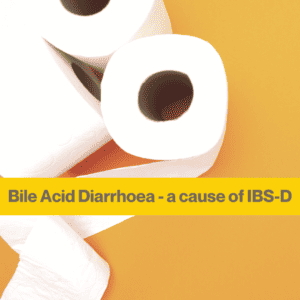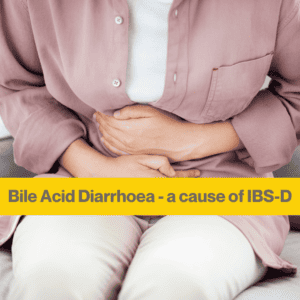Struggling with IBS-D? Did you know it could be related to bile acid diarrhoea (BAD)? You might not have heard of this, but some studies show that around 34% of people with Diarrhoea predominant IBS may have bile acid malabsorption.
What are bile acids?
Bile is made in the liver, and stored in the gallbladder. When you eat food your gallbladder releases bile to help the breakdown of fats in your meal.
Bile acids are made from cholesterol, and help fats emulsify so we can absorb triglycerides, cholesterol, and lipid-soluble vitamins throughout the small intestine.
They should mostly be reabsorbed back into the bloodstream to be recycled as the food waste moves towards the end of the small intestine. Around 2-5% will be lost in your poo. If the acids aren’t reabsorbed, then these can travel to the large intestine causing irritation. This is called bile acid malabsorption.
Bile Acid Malabsorption (BAM) is thought to affect 1 in 100 people, but around a third of people with IBS-D.
- Listen to my podcast episode about dietary fats and IBS – Episode 23 of the Inside Knowledge podcast
What are the symptoms of bile acid malabsorption?
Watery diarrhoea is the most common complaint, often over a long time period.
When you have a large amount of bile acids entering the large intestine, and not getting reabsorbed, it can irritate the gut, and cause water to be drawn in.
This can cause symptoms such as diarrhoea, pain, cramps, urgency and even incontinence as your body quickly tries to get rid of the excess bile acids and liquid.
Your diarrhoea may be green or yellow, potentially indicating malabsorption of fats and high bile content.

Factors affecting bile acid absorption
Some bile acid malabsorption is idiopathic, meaning doctors don’t know why it’s happening to you. Other factors known to cause these symptoms include:
- If you’ve had some damage to your small intestine, or part of the ileum removed (ileostomy) due to Crohn’s Disease or other surgery.
- An overgrowth of bacteria in the small intestine affecting reabsorption of the bile acids (SIBO). SIBO may also increase small intestine transit time due to carbohydrate malabsorption
- Digestive conditions affecting digestion, such as removal of the gallbladder, pancreatitis, coeliac disease or Crohn’s.
- Producing too much bile acid due to impaired feedback loop from a hormone in the ileum, fibroblast growth factor 19 (FGF19). If this feedback loop to the liver isn’t working well, then more bile acids will be produced than your body needs. Certain bacteria in your gut can reduce the effectiveness of this process. (see below)
Testing for BAM
Your doctor may prescribe a treatment without running a test first. This is because there isn’t a good test freely available. Tests for bile acid malabsorption are not available in all countries, they are expensive, or not always considered an accurate measurement.
Potential tests include:
- selenium homocholic acid taurine (SeHCAT) – You can test for levels of bile acid reabsorption in the body by swallowing a capsule with a tiny amount of radiation and some fake bile acids. After 7 days another test looks at how much of the synthetic bile acids have remained in your body, and how much was excreted.
- Blood tests
- The other way to test is to look at the levels of bile acid in your poo. This can be done in a stool test, sometimes over multiple days.
- A private stool test like the ones I can run as part of the Gut Reset look at bile acid levels, although this is only one point in time.
Bile acids in the gut
The small amount of bile salts reaching the large intestine will normally be eliminated in your poo.
Before this happens some gut bacteria can get to work on them in the small intestine and colon, creating secondary bile acids. These microbes unhook the bile salt from its carrier molecules of taurine or glycine. This process is called deconjugation.
Certain bacteria are known to deconjugate bile acids in the large intestine, potentially leading to symptoms of BAD.
Gut bacteria can create metabolites which signal to your liver to reduce production of more bile salts. If your gut microbes are not sending the correct messages to the liver you may end up with more salts in the colon, causing loose stools, pain and urgency.
Many types of bacteria are known to play a part in this process, including Lactobacillus and Bifidobacterium, and Clostridium and Enterococcus. The archea Methanobrevibacter smithii and Methanosphera stadmanae can also affect this process.
This is a two way relationship.
Bacteria can affect your bile acid deconjugation. And a high concentration of bile acids may also affect the gut microbiota. Studies have shown bile salts can affect the size and the composition of the intestinal microbiota.
People with bile acid malabsorption may have different gut microbes compared to people with IBS-D.
Treatment for Bile acid malabsorption
If your bile acid malabsorption is secondary to another condition (e.g. Crohn’s or coeliac disease) the first line treatment will be for that condition.
If your BAD is idiopathic (i.e. cause unknown) your doctor may prescribe some medication, called bile acid sequestrants. These help bind the bile acids in the large intestine, and stop them causing the frequent loose stools.
- Colesevelam – not currently licensed for bile acid malabsorption, but used ‘off label’
- Colestyramine
These are cholesterol lowering medications sometimes used by doctors for bile acid malabsorption. Bile acids are made from cholesterol. By binding them and taking them out of the body you can lower your cholesterol levels, and also remove bile salts from the large intestine.

What about low bile acids?
If you’re not producing enough bile, perhaps due to congestion in the gallbladder, gallbladder removal, or gall stones, you might experience symptoms such as:
- Constipation
- Fat malabsorption
- Fatty stools
- Nausea
Bile acids are also anti-microbial, helping to defend your small intestine from pathogens. If they are low, you may be more at risk for SIBO. Bile salts also help to stimulate the Migrating Motor Complex.
Diet for bile acid diarrhoea
Evidence for a diet to support BAD is sparce. However, most advice seems to include:
- Increasing the amount of fibre that you eat may help to remove some of the high bile acids.
- A very low fat diet of under 40g per day
Coffee may also stimulate the release of bile from the gall bladder, so consider how much you’re drinking every day.
1. Fibre for bile acid diarrhoea
Eating a higher fibre diet can affect your levels of bile acids because fibre helps to bind the bile acids, as well as feeding beneficial gut microbes that support the gut lining.
Experiments in animals have shown dietary fibre not only suppresses the reabsorption of bile acids, but can also reduce circulating levels without excess excretion in the faeces. Viscose fibres such as seaweed, oats, and chickpeas can help with this.
You should be aiming for between 25-30g of fibre a day.
Some people find taking a supplement of Partially Hydrolysed Guar Gum (PHGG) helpful to bind the bile acids. Results supplementing with psyllium are also good.
Other fibres like pectin (in apples), and cellulose can do the same job. Variety in the types of fibre you eat is important for this reason.
2. Fat reduction for BAD
Some people feel better when they restrict the fats they eat. Research has shown a low fat diet could provide a statistically significant improvement in abdominal pain and nocturnal defecation, or an improvement in bowel frequency, urgency, flatulence, belching, borborygmi and stool consistency, although these latter symptoms were not significant.
It’s best to work with a nutrition professional to get your balance of macro nutrients right and ensure you’re getting what you need from your food. Consider whether you may need to supplement with fat soluble nutrients such as vitamin A, E, D, and K as these are fat soluble.
Low fat foods contain around 3g of fat per 100g. If you’re aiming for under 40g per day you’ll need to limit fatty cuts of meat, butter, full fat dairy, chocolates, ice-cream, and some baked goods like biscuits and cakes etc.
You don’t want to go too low with fats or calories either. Partly because you might not be eating enough nutrients, but also because it’s possible for the gallbladder to go to sleep (called gallbladder stasis) which can lead to sludge or small gallstones forming.
If you want some help with what to eat for your IBS to get in touch to talk about how I can help – info@goodnessme-nutrition.com.

IBS Nutritionist
Hi, I'm Anna Mapson, registered Nutritional Therapist.
I help people with IBS and SIBO get control of unpredictable gut symptoms to find long term relief from painful and embarrassing IBS without restrictive dieting.
I can help you to:
- understand your digestion better, so you recognise your triggers
- eat a well balanced diet, with tasty meals that are simple to prepare
- reintroduce your trigger foods so you can get back to enjoying food again
Find more about my 3 month 1:1 Gut Reset programme.
Are prebiotics good for IBS?
If you've tried taking prebiotics for your IBS you might have noticed they can really make a big impact. And not always in a good way! Prebiotics are a type of short chain sugars found in plant foods, and they also help to feed our healthy gut bacteria. Many people...
Why does my stomach rumble? Causes of noisy digestion
Ever interrupted a meeting with a loud stomach rumble? Or heard sounds in there like a blocked drain is being cleared? Whilst it can be embarrassing, stomach noises aren't normally anything to worry about, it's often just food and liquid moving through your digestion....
How Many Times Should I Chew My Food?
Have you ever noticed how many times you chew your food? It might be something you think about much, but when I'm working with my clients it's something I ask people to think about. I've got four reasons why you should probably be chewing more than you currently are...





Need help compiling a low fat diet